Page 4 of 468
ii
Table of Contents
Windows
Keys and Door Locks
Keyless Entry System (If Equipped)
Tailgate
Automatic Transmission
Manual Transmission
Four-Wheel Drive Operation (If Equipped)
Parking Brake
Tilt Wheel (If Equipped)
Turn Signal/Multifunction LeverWindshield Wipers
Cruise Control
Exterior and Interior Lamps
Mirrors
Storage Compartments
Accessory Power Outlets
OnStar® System (Option)
Instrument Panel, Warning Lights and Gages
Message Center Seats and Seat Controls
Safety BeltsAir Bag System
Restraint Systems for Children
Section
1
Section
2
Seats and Restraint Systems
Features and Controls
Page 84 of 468

2-
2-1
Section 2 Features and Controls
Here you can learn about the many standard and optional features on your vehicle, and information on starting,
shifting and braking. Also explained are the instrument panel and the warning systems that tell you if everything is
working properly
-- and what to do if you have a problem.
2
-1 Windows
2-5 Keys
2-6 Door Locks
2-10 Keyless Entry System (If Equipped)
2-13 Rear Doors
2-14 Tailgate
2-15 Theft
2-16 Content Theft-Deterrent (If Equipped)
2-17 Passlock�
2-18 New Vehicle ªBreak-Inº
2-18 Ignition Positions
2-20 Starting Your Engine
2-23 Engine Coolant Heater (If Equipped)
2-24 Automatic Transmission Operation
2-28 Manual Transmission Operation
2-34 Four-Wheel Drive (If Equipped)
2-43 Parking Brake
2-44 Shifting Into PARK (P)
(Automatic Transmission Only)2
-46 Shifting Out of PARK (P)
(Automatic Transmission Only)
2
-47 Parking Your Vehicle
(Manual Transmission Models Only)
2
-47 Parking Over Things That Burn
2-48 Engine Exhaust
2-48 Running Your Engine While You're Parked
(Automatic Transmission)
2
-49 Manual Selectable Ride (If Equipped)
2-51 Locking Rear Axle
2-52 Turn Signal/Multifunction Lever
2-58 Exterior Lamps
2-61 Interior Lamps
2-63 Mirrors
2-76 OnStar� System (If Equipped)
2-80 The Instrument Panel - Your
Information System
2
-82 Instrument Panel Cluster
2-84 Warning Lights, Gages and Indicators
2-99 Message Center
Page 98 of 468

2-15
Theft
Vehicle theft is big business, especially in some cities.
Although your vehicle has a number of theft
-deterrent
features, we know that nothing we put on it can make it
impossible to steal. However, there are ways you can help.
Key in the Ignition
If you leave your vehicle with the keys inside, it's an
easy target for joy riders or professional thieves
-- so
don't do it.
When you park your vehicle and open the driver's door,
you'll hear a chime reminding you to remove your key
from the ignition and take it with you. Always do this.
If you have a manual transmission, your steering wheel
will be locked, and so will your ignition. If you have an
automatic transmission, your ignition and transmission
will be locked. Also remember to lock the doors.
If the key is in the ignition, with any door open, and you
try to lock your doors with the power door locks, the
driver's door will not stay locked. This will help to keep
you from locking your keys in the vehicle.
Parking at Night
Park in a lighted spot, close all windows and lock your
vehicle. Remember to keep your valuables out of sight.
Put them in a storage area, or take them with you.
Parking Lots
Even if you park in a lot where someone will be
watching your vehicle, it's still best to lock it up and
take your keys. But what if you have to leave your
ignition key? What if you have to leave something
valuable in your vehicle?
�Put your valuables in a storage area, like your
glove box.
�Valuables can be locked in the center floor console.
�If your vehicle has a remote keyless entry system,
take the transmitter with you.
�Lock all the doors except the driver's.
Page 102 of 468
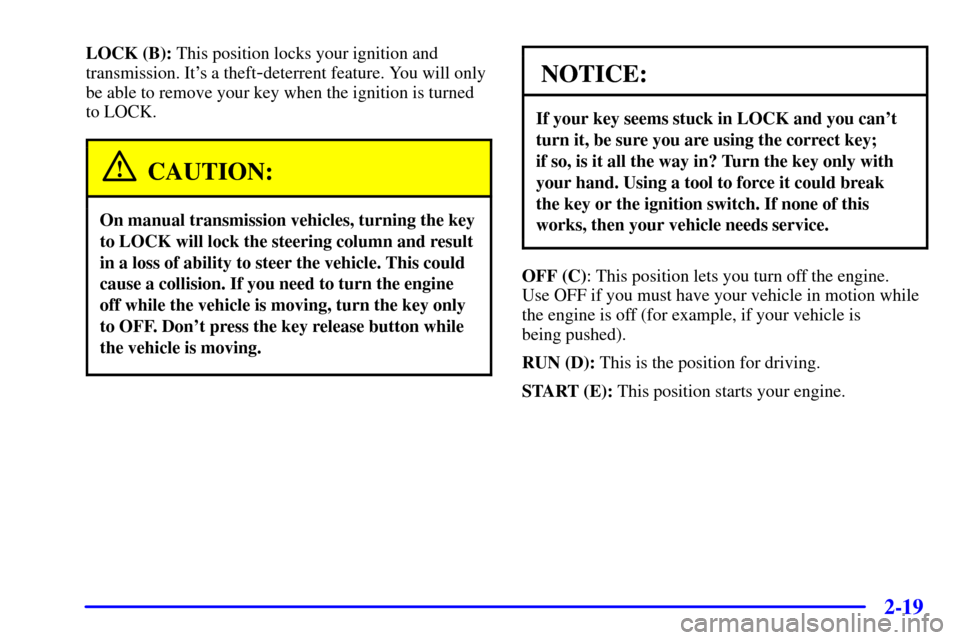
2-19
LOCK (B): This position locks your ignition and
transmission. It's a theft
-deterrent feature. You will only
be able to remove your key when the ignition is turned
to LOCK.
CAUTION:
On manual transmission vehicles, turning the key
to LOCK will lock the steering column and result
in a loss of ability to steer the vehicle. This could
cause a collision. If you need to turn the engine
off while the vehicle is moving, turn the key only
to OFF. Don't press the key release button while
the vehicle is moving.
NOTICE:
If your key seems stuck in LOCK and you can't
turn it, be sure you are using the correct key;
if so, is it all the way in? Turn the key only with
your hand. Using a tool to force it could break
the key or the ignition switch. If none of this
works, then your vehicle needs service.
OFF (C): This position lets you turn off the engine.
Use OFF if you must have your vehicle in motion while
the engine is off (for example, if your vehicle is
being pushed).
RUN (D): This is the position for driving.
START (E): This position starts your engine.
Page 103 of 468
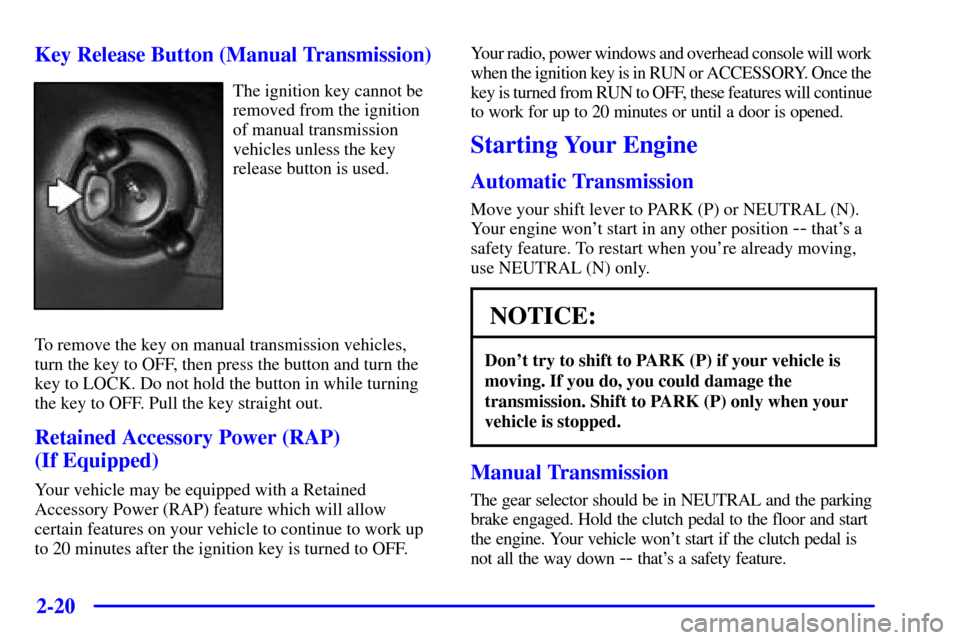
2-20
Key Release Button (Manual Transmission)
The ignition key cannot be
removed from the ignition
of manual transmission
vehicles unless the key
release button is used.
To remove the key on manual transmission vehicles,
turn the key to OFF, then press the button and turn the
key to LOCK. Do not hold the button in while turning
the key to OFF. Pull the key straight out.
Retained Accessory Power (RAP)
(If Equipped)
Your vehicle may be equipped with a Retained
Accessory Power (RAP) feature which will allow
certain features on your vehicle to continue to work up
to 20 minutes after the ignition key is turned to OFF.Your radio, power windows and overhead console will work
when the ignition key is in RUN or ACCESSORY. Once the
key is turned from RUN to OFF, these features will continue
to work for up to 20 minutes or until a door is opened.
Starting Your Engine
Automatic Transmission
Move your shift lever to PARK (P) or NEUTRAL (N).
Your engine won't start in any other position
-- that's a
safety feature. To restart when you're already moving,
use NEUTRAL (N) only.
NOTICE:
Don't try to shift to PARK (P) if your vehicle is
moving. If you do, you could damage the
transmission. Shift to PARK (P) only when your
vehicle is stopped.
Manual Transmission
The gear selector should be in NEUTRAL and the parking
brake engaged. Hold the clutch pedal to the floor and start
the engine. Your vehicle won't start if the clutch pedal is
not all the way down
-- that's a safety feature.
Page 107 of 468
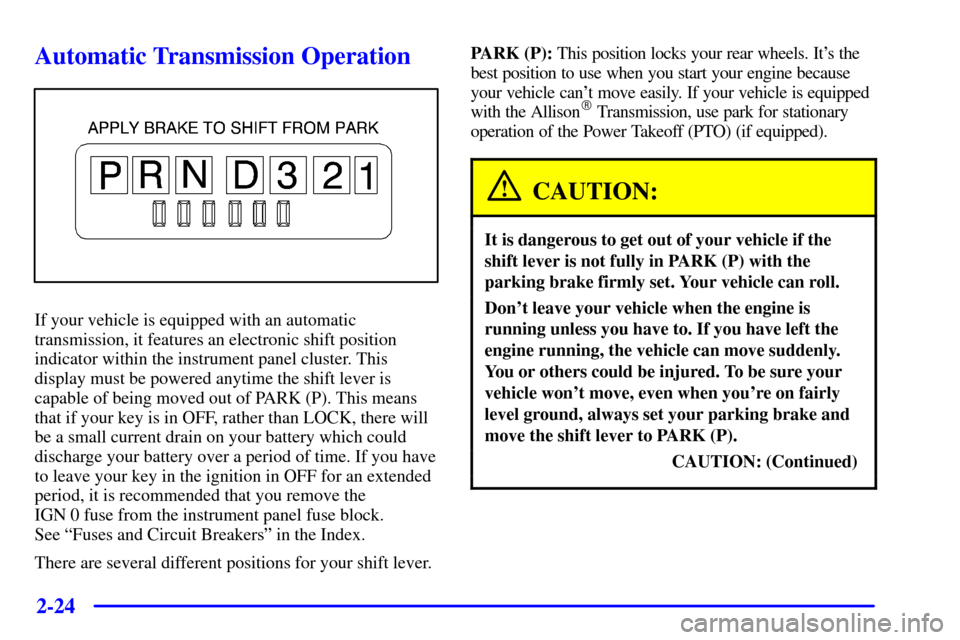
2-24
Automatic Transmission Operation
If your vehicle is equipped with an automatic
transmission, it features an electronic shift position
indicator within the instrument panel cluster. This
display must be powered anytime the shift lever is
capable of being moved out of PARK (P). This means
that if your key is in OFF, rather than LOCK, there will
be a small current drain on your battery which could
discharge your battery over a period of time. If you have
to leave your key in the ignition in OFF for an extended
period, it is recommended that you remove the
IGN 0 fuse from the instrument panel fuse block.
See ªFuses and Circuit Breakersº in the Index.
There are several different positions for your shift lever.PARK (P): This position locks your rear wheels. It's the
best position to use when you start your engine because
your vehicle can't move easily. If your vehicle is equipped
with the Allison
� Transmission, use park for stationary
operation of the Power Takeoff (PTO) (if equipped).
CAUTION:
It is dangerous to get out of your vehicle if the
shift lever is not fully in PARK (P) with the
parking brake firmly set. Your vehicle can roll.
Don't leave your vehicle when the engine is
running unless you have to. If you have left the
engine running, the vehicle can move suddenly.
You or others could be injured. To be sure your
vehicle won't move, even when you're on fairly
level ground, always set your parking brake and
move the shift lever to PARK (P).
CAUTION: (Continued)
Page 108 of 468
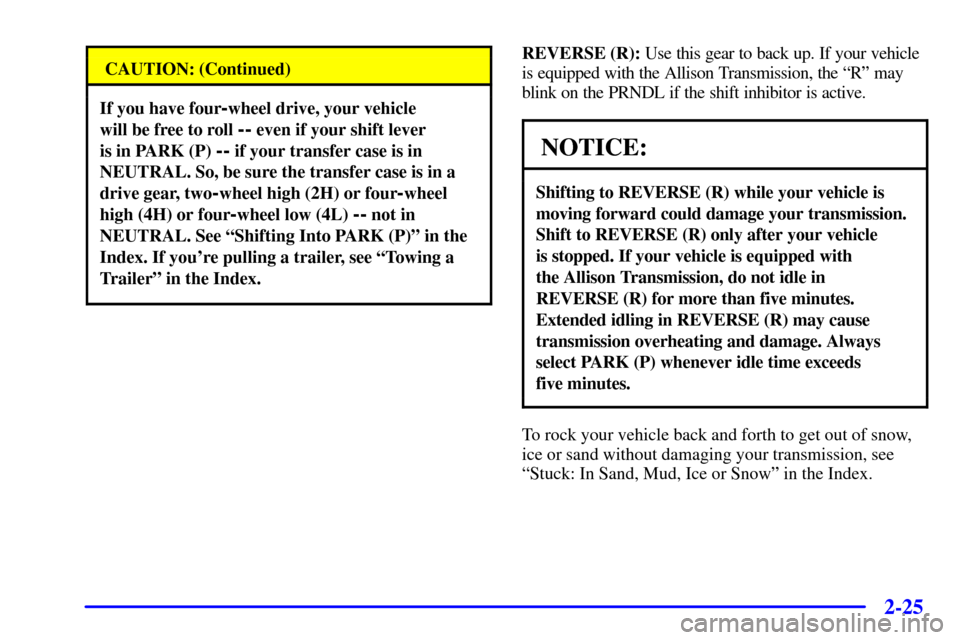
2-25
CAUTION: (Continued)
If you have four-wheel drive, your vehicle
will be free to roll
-- even if your shift lever
is in PARK (P)
-- if your transfer case is in
NEUTRAL. So, be sure the transfer case is in a
drive gear, two
-wheel high (2H) or four-wheel
high (4H) or four
-wheel low (4L) -- not in
NEUTRAL. See ªShifting Into PARK (P)º in the
Index. If you're pulling a trailer, see ªTowing a
Trailerº in the Index.
REVERSE (R): Use this gear to back up. If your vehicle
is equipped with the Allison Transmission, the ªRº may
blink on the PRNDL if the shift inhibitor is active.
NOTICE:
Shifting to REVERSE (R) while your vehicle is
moving forward could damage your transmission.
Shift to REVERSE (R) only after your vehicle
is stopped. If your vehicle is equipped with
the Allison Transmission, do not idle in
REVERSE (R) for more than five minutes.
Extended idling in REVERSE (R) may cause
transmission overheating and damage. Always
select PARK (P) whenever idle time exceeds
five minutes.
To rock your vehicle back and forth to get out of snow,
ice or sand without damaging your transmission, see
ªStuck: In Sand, Mud, Ice or Snowº in the Index.
Page 109 of 468
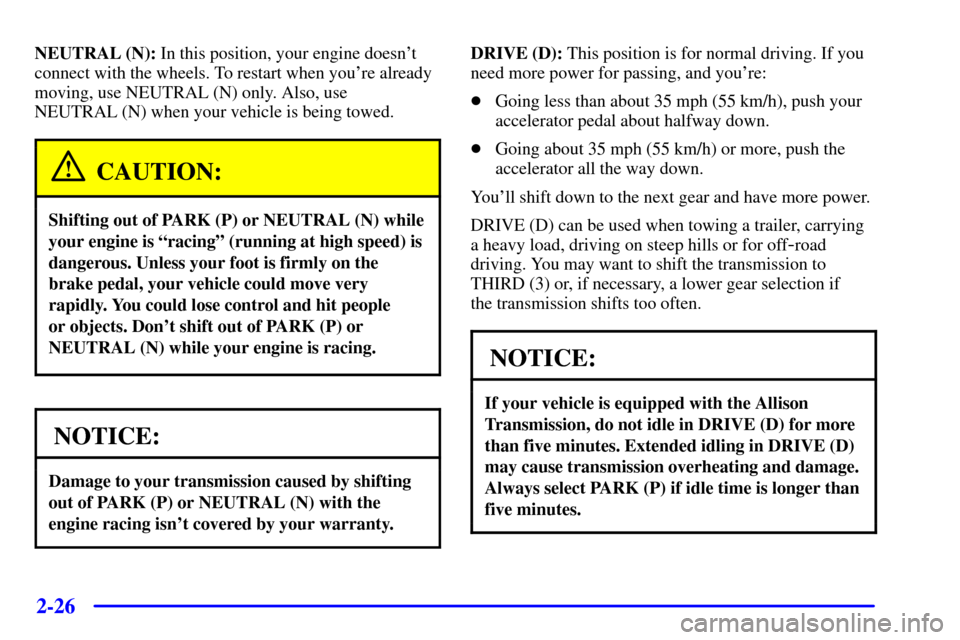
2-26
NEUTRAL (N): In this position, your engine doesn't
connect with the wheels. To restart when you're already
moving, use NEUTRAL (N) only. Also, use
NEUTRAL (N) when your vehicle is being towed.
CAUTION:
Shifting out of PARK (P) or NEUTRAL (N) while
your engine is ªracingº (running at high speed) is
dangerous. Unless your foot is firmly on the
brake pedal, your vehicle could move very
rapidly. You could lose control and hit people
or objects. Don't shift out of PARK (P) or
NEUTRAL (N) while your engine is racing.
NOTICE:
Damage to your transmission caused by shifting
out of PARK (P) or NEUTRAL (N) with the
engine racing isn't covered by your warranty.
DRIVE (D): This position is for normal driving. If you
need more power for passing, and you're:
�Going less than about 35 mph (55 km/h), push your
accelerator pedal about halfway down.
�Going about 35 mph (55 km/h) or more, push the
accelerator all the way down.
You'll shift down to the next gear and have more power.
DRIVE (D) can be used when towing a trailer, carrying
a heavy load, driving on steep hills or for off
-road
driving. You may want to shift the transmission to
THIRD (3) or, if necessary, a lower gear selection if
the transmission shifts too often.
NOTICE:
If your vehicle is equipped with the Allison
Transmission, do not idle in DRIVE (D) for more
than five minutes. Extended idling in DRIVE (D)
may cause transmission overheating and damage.
Always select PARK (P) if idle time is longer than
five minutes.